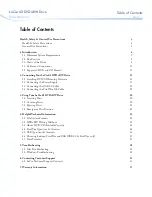
11
4 PRECAUTIONS FOR USE OF THE INVERTER
The FR-F700 series is a highly reliable product, but incorrect peripheral circuit making or operation/handling method may
shorten the product life or damage the product.
Before starting operation, always recheck the following items:
앫
Use crimping terminals with insulation sleeve to wire the power supply and motor.
앫
Application of power to the output terminals (U, V, W) of the inverter will damage the inverter. Never perform such wiring.
앫
After wiring, wire offcuts must not be left in the inverter.
Wire offcuts can cause an alarm, failure or malfunction. Always keep the inverter clean. When drilling mounting holes in
a control box etc., take care not to allow chips and other foreign matter to enter the inverter.
앫
Use cables of the appropriate size to make a voltage drop of 2% maximum.
If the wiring distance is long between the inverter and motor, a main circuit cable voltage drop will cause the motor
torque to decrease especially at the output of a low frequency.
Refer to
for the recommended cable size.
앫
The overall wiring length should be within the prescribed length.
Especially for long distance wiring, the fast-response current limit function may be reduced or the equipment connected
to the inverter output side may malfunction or become faulty under the influence of a charging current due to the stray
capacity of the wiring. Therefore, note the overall wiring length. (Refer to
)
앫
Electromagnetic Compatibility
Operation of the frequency inverter can cause electromagnetic interference in the input and output that can be
propagated by cable (via the power input lines), by wireless radiation to nearby equipment (e.g. AM radios) or via data
and signal lines. Activate the integrated EMC filter (and an additional optional filter if present) to reduce air propagated
interference on the input side of the inverter. Use AC or DC reactors to reduce line propagated noise (harmonics). Use
shielded motor power lines to reduce output noise.
앫
Do not install a power factor correction capacitor, varistor or arrester on the inverter output side. This will cause the
inverter to trip or the capacitor, varistor, or arrester to be damaged. If any of the above devices is installed, immediately
remove it.
앫
Before starting wiring or other work after the inverter is operated, wait for at least 10 minutes after the power supply has
been switched off, and check that there are no residual voltage using a tester or the like. The capacitor is charged with
high voltage for some time after power off and it is dangerous.
앫
A short circuit or earth fault on the inverter output side may damage the inverter modules.
– Fully check the insulation resistance of the circuit prior to inverter operation since repeated short circuits caused by
peripheral circuit inadequacy or an earth fault caused by wiring inadequacy or reduced motor insulation resistance
may damage the inverter modules.
– Fully check the to-earth insulation and inter-phase insulation of the inverter output side before power-on.
Especially for an old motor or use in hostile atmosphere, securely check the motor insulation resistance etc.
앫
Do not use the inverter input side magnetic contactor to start/stop the inverter.
Since repeated inrush currents at power ON will shorten the life of the converter circuit (switching life is about 1,000,000
times), frequent starts and stops of the MC must be avoided.
Always use the start signal (ON/OFF of STF and STR signals) to start/stop the inverter.
앫
Do not apply a voltage higher than the permissible voltage to the inverter I/O signal circuits.
Contact to the inverter I/O signal circuits or opposite polarity may damage the I/O devices. Especially check the wiring to
prevent the speed setting potentiometer from being connected incorrectly to short terminals 10E and
5.
앫
Provide electrical and mechanical interlocks for MC1 and
MC2 which are used for commercial power supply-
inverter switch-over.
When the wiring is incorrect or if there is a commercial
power supply-inverter switch-over circuit as shown on the
right, the inverter will be damaged by leakage current
from the power supply due to arcs generated at the time
of switch-over or chattering caused by a sequence error.
앫
If the machine must not be restarted when power is
restored after a power failure, provide a magnetic contactor in the inverter's input side and also make up a sequence
which will not switch on the start signal.
If the start signal (start switch) remains on after a power failure, the inverter will automatically restart as soon as the
power is restored.
Inverter
Undesirable current
Interlock
Power supply
















































